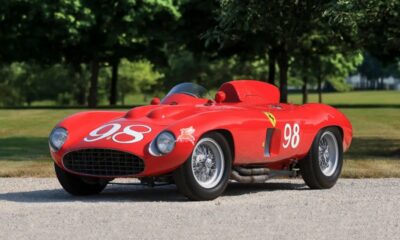Travel
Studying Abroad: Top 10 Toughest Education Systems in the World

Higher education abroad is becoming more and more popular among students looking to boost their career prospects. A student’s selection of the appropriate country is just as crucial as their courses and universities. There are differences in the intensity of education systems across the globe. A country’s culture, governmental policies, and economic standing are some of the factors that affect its educational system. Some countries have longer school days or more challenging academic requirements for their students.
The structure of the educational system, the country’s most challenging exam, tertiary education attainment, the most popular degree, the prevalence of stress among students, the acceptance rate of the best college in that nation, and average national IQ scores are some of the factors that MastersDegree.net has taken into consideration when ranking some of the world’s toughest education systems.
1. South Korea
Education System: The four primary phases of the South Korean school system are six years for elementary school, three years for middle school, three years for high school, and either four years for university studies or two to three years for junior college. Usually, the academic year begins in March, with a second semester starting in late August.
Most Difficult Exam: The Suneung College entrance exam is the most difficult in South Korea. It covers a range of topics over eight hours. Thought to be among the most difficult tests in the world, the results determine many things, including the university you can attend, the type of job you can get, and even the course of your future relationships.
Korean students stay late to tutor and take exams until 10 or 11 p.m. after school. Upon arriving home, they study alone until one or two in the morning. To prepare for the Suneung exam, high school students in Korea typically study for 16 hours every day.
Stress Level in Students: According to a 2022 South Korean survey, 35.6% of students reported feeling stressed out during two weeks at school. It’s interesting to note that stress levels were higher among college and post-college students than among elementary, middle, and high school students. In South Korea, the average IQ is 106.
Most Popular Degrees: Business courses are also very popular in South Korea, but most people there prefer to study the arts and sciences. Approximately 52% of adults aged 25 to 64 completed their higher education in 2021, a rise from the previous year. In South Korea, the proportion of adults with higher education has increased by 33.6 percentage points since 1995.
Over 27,000 students enroll in undergraduate and graduate programs at Seoul National University each year. Nonetheless, there are only a small number of foreign exchange students—typically in the 200s. SNU has a 15% acceptance rate for new students.
2. Finland
Education System: The 9-3-3 structure is used in the Finnish educational system. Nine years of mandatory schooling are followed by three years of upper secondary and three years of higher education.
Hardest Exam: The Finnish Matriculation Examination, which is administered nationwide and is typically taken by high school graduates in Finland. Its primary goal is to assess students’ mastery of the necessary knowledge and skills during their high school years and determine whether or not their maturation has coincided with the educational goals.
Students can continue their education at universities and other higher education institutions if they pass this exam. Every year, about 30,000 applicants pass the test; 25,000 of them do so in the spring.
Stress Level among Students: University students in Finland face more mental health problems than other adults in the nation, according to the most recent survey on the health and well-being of Finnish students. In particular, 28% of male students and 40% of female students said they felt depressed or anxious.
Most Popular Degrees: In Finland, information technology (IT) and international business logistics are the most in-demand study subjects. In Finland, the proportion of adults with a postsecondary degree has remained constant, rising from 39% to 40%.
The University of Helsinki, the top university in Finland, admits only 17% of applicants. Finland has an average IQ of 101.2.
3. Singapore
Education System: Six years of primary school, four to six years of secondary school, and one to three years of postsecondary education make up the first three years of education.
Hardest Exam: The Singapore-Cambridge GCE A-Level is one of the most difficult exams to take in Singapore. It’s not hyperbole to say that the questions are extremely difficult and you will be competing against some of Singapore’s best students.
10,930 candidates in all took part in the 2022 GCE A-Level exam. Remarkably, 10,206 candidates, or 93.4% of the total, passed with at least three H2 passes, including a pass in Knowledge and Inquiry (KI) or General Paper (GP). This performance level is consistent with historical patterns seen in GCE A-Level Exams from prior years.
Stress Level Among Students: Sixty-three percent of young respondents, aged 16 to 24, who participated in a recent Rakuten Insight survey about mental health and well-being in Singapore stated they had experienced increased levels of stress or anxiety in the previous year.
Most Popular Degrees: In Singapore, engineering, business, and health sciences degrees are the most sought-after. In Singapore, 97.1% of eligible students were enrolled in postsecondary education in 2021. Additionally, Singapore has an average IQ of 105.9.
International students are welcome at the National University of Singapore (NUS). The university only accepts sixteen percent of applicants, which is a competitive admission rate.
4. China
Education System: Six years of elementary school, starting at age six and lasting until age twelve. Students then spend three years in middle school and three years in high school.
Hardest Exam: China’s national college entrance exam is called the Gaokao, or Nationwide Unified Examination for Admissions to General Universities and Colleges. Every year, in the first part of June, it’s an important exam for students hoping to get into undergraduate programs.
The Gaokao exam period will begin on June 7, 2023, and last two to four days, depending on the province. The most students have ever participated in the Gaokao, with a record-breaking 12.91 million students participating in 2023—980,000 more than the year before.
Students’ Stress Level: According to research, stress levels among Chinese college students were higher both before and after they returned to school. In comparison to a previous study that found only 28.79% of students experienced stress, approximately 67.50% of students reported having moderate to high levels of stress.
Most Popular Degrees: International Economics and Trade, Clinical Medicine, and Computer Science and Technology are among the most sought-after degrees in China. With 46.55 million degree holders, or approximately 59.6% of the eligible age group in China, were enrolled in postsecondary education in 2022. The average IQ in China is 104.10.
With a mere 1% acceptance rate, Peking University, the top university in China, is very competitive for domestic students. With a 15% acceptance rate, it is more accessible for students from abroad.
5. Japan
Education System: After completing six years of elementary school, students proceed to three years of lower secondary education. This equals nine years of required schooling. The upper secondary school follows, lasting an additional three years.
Hardest Exam: The National Center Test for University Admissions is a significant examination taken by Japanese applicants to universities. More than 500,000 students take it over two days in January. The six subjects comprise 29 distinct tests, the selection of which depends on the university a student wishes to attend.
Level of Stress Among Students: In Japan, 84.0% of male students and 95.1% of female students report feeling stressed.
Most Popular Degrees: Business and Economics degrees, along with degrees in science and technology, are the most sought-after. One in five individuals possess a postsecondary education. Japan has an average IQ of 106.5.
These universities typically have extremely low undergraduate acceptance rates, which can range from 5% to 30% or even lower for extremely competitive programs.
6. Hong Kong
Education System: Students receive three years of junior secondary education after six years of primary education. There are then three years of senior secondary school and four years of postsecondary education.
Hardest Exam: The primary exam for Form 6 students in mainstream schools is the HKDSE (Hong Kong Diploma of Education). Exam difficulty is well-known, with the Chinese and English Paper 3 sections being particularly challenging.
It’s a good option for students who want to attend a Hong Kong university and prefer traditional teaching methods and memorization, though some foreign universities will also accept this diploma. Using traditional characters, the exam’s level of Chinese language proficiency is fairly high.
Stress Level Among Students: It is estimated that 48.6% of students in Hong Kong are under stress.
Most Popular Degrees: The most popular degrees are in health care, engineering, architecture, commerce, and business. In 2022, 104% of students enrolled in postsecondary education, indicating a high level of participation in higher education. In Hong Kong, the average IQ is 107.
Regarding the University of Hong Kong, its projected acceptance rate for the 2019–2020 admission cycle is roughly 37%.
7. Taiwan
Education System: Six years of elementary school, three years of junior high school, three years of senior high school, and four years of postsecondary education.
Hardest Exam: The GSAT is an important exam that evaluates high school students’ foundational knowledge to ascertain whether they are prepared for college. A maximum score of 75 is awarded for subjects like Science, Social Studies, Mathematics, Chinese, and English.
Depending on the subject, the test has multiple-choice, response writing, and essay-writing question types. Students who intend to apply directly or participate in specific programs require a GSAT score. Every year, the exam is usually held in January.
Stress Level Among Students: The two biggest sources of stress for respondents were academic tests (45.6%) and school-related factors (56.7%).
Most Popular Degrees: Social sciences and engineering and technology are popular degrees.
In Taiwan, 45% of people have completed their higher education. The IQ is 106.5 on average.
As one of Taiwan’s top universities, the University of Taipei has a 50% admission rate.
8. South Africa
Education System: Students complete four years of elementary school, then three years of lower secondary school, three years of upper secondary school, and three years of postsecondary education.
Hardest Exam: In South Africa, the National Senior Certificate (NSC) exams, also known as “matriculation,” are a major annual event. They signal the conclusion of twelve years of formal schooling and provide insight into the state of the educational system as a whole. A highly decentralized system was used for the first national exam administered under the new democratic government in November 1996.
Stress Level among Students: Of the student body, 41.8% of males and 58.2% of females reported feeling mentally distressed.
Most Popular Degrees: In South Africa, degrees in business, economics, and health are among the most sought-after degrees. 69 is the average IQ.
In 2021, the gross tertiary enrollment ratio in South Africa stayed constant at roughly 25.24 percent. The gross tertiary enrollment ratio peaked in South Africa in 2021, at 25.24 percent.
The University of Cape Town, one of the top universities in South Africa, has an acceptance rate of about 50%.
9. United States
Education System: There are 13 years of formal education in the K–12–4 education system used in the United States. Starting in kindergarten, students will receive 12 years of primary and secondary education. A further 4 years of higher education are optional for those wishing to pursue a university degree.
Hardest Exam: The Graduate Record Examination (GRE), a standardized test that is frequently taken, especially in the US and some other countries, to gain admission to graduate programs (master’s and doctoral degrees) in a variety of fields. Its purpose is to evaluate your potential for success in graduate-level studies as well as your preparedness for advanced academic work.
Students’ Stress Level: During their academic journey, 67% of American students report feeling stressed.
Most Popular Degrees: Business, health, and social sciences are the most sought-after degree programs among students. Approximately 44% of Americans who are 25 years of age or older have gone to college and finished their degrees, with the majority having earned bachelor’s degrees. In the United States, the average IQ is 98.
Harvard University is one of the most esteemed universities in America when it comes to prestige. With an admission rate as low as 4%, getting into Harvard is extremely competitive.
10. Russia
Education System: After four years of basic secondary education, students complete four years of primary education. Following that, there are two years of comprehensive secondary education and four years of university-level education.
Hardest Exam: Every high school graduate in Russia is required to take the Unified State Exam (also known as EGE or EБЭ) to be eligible for admission to a professional college or university. In Russia, passing these tests is a must for continuing education.
Stress Level Among Students: 55.4% of students report feeling stressed out.
Most Popular Degrees: Business, finance, engineering, and area studies are a few of the most sought-after degree specializations. The average IQ is 96, and 54% of people have completed their tertiary education.
With a mere 12% acceptance rate, admission to prestigious universities such as Moscow State University is highly competitive.
Methodology for Evaluating the World’s Top 10 Toughest Education Systems
In evaluating the ten most rigorous educational systems globally, the methodology encompasses seven essential metrics:
- Curriculum rigor and educational standards are evaluated in the education system structure.
- Toughest National Exam: Determining the hardest national exam in each nation, with an emphasis on significance and difficulty.
- Tertiary Education Prevalence (age 25–64): Calculating the proportion of the population with a postsecondary degree.
- Most Popular Degree: Figuring out which degree or subject of study is most sought after.
- Student Stress Prevalence: Assessing students’ mental health and stress levels related to school.
- National IQ Scores: Adding average IQ as an additional indicator of cognitive capacity.
- Top College Acceptance Rate: Examining the nation’s top university’s level of selection.
-

 Business3 weeks ago
Business3 weeks agoPrakash and Kamal Hinduja: Driving Social and Environmental Change
-
Education4 weeks ago
Fred DuVal: University Leadership as a Critical Resource for Climate Change Research and Life-Saving Solutions
-

 Health3 weeks ago
Health3 weeks agoThe Hinduja Brothers Commitment to Global Health: Empowering Communities Across Borders
-

 Cryptocurrency3 weeks ago
Cryptocurrency3 weeks agoDesigned For The Masses: How Akasha (AK1111) Is Unlocking Crypto For The Next Billion Users
-

 Cryptocurrency4 weeks ago
Cryptocurrency4 weeks agoNexaglobal & Future World Token (FWT): Could This Be the Next Big Crypto Investment of 2025?
-

 Sports4 weeks ago
Sports4 weeks agoWomen’s NCAA Tournament 2025 Sweet 16: Full Schedule, Fixtures, Teams, Bracket, and How to Watch March Madness Basketball Match Live
-

 Startup1 week ago
Startup1 week agoCost-Saving Strategies Every Small Business Owner Should Know to Boost Efficiency
-

 Startup3 weeks ago
Startup3 weeks agoMatthew Denegre on the Art of Deal Sourcing: Finding the Right Investment Opportunities

























